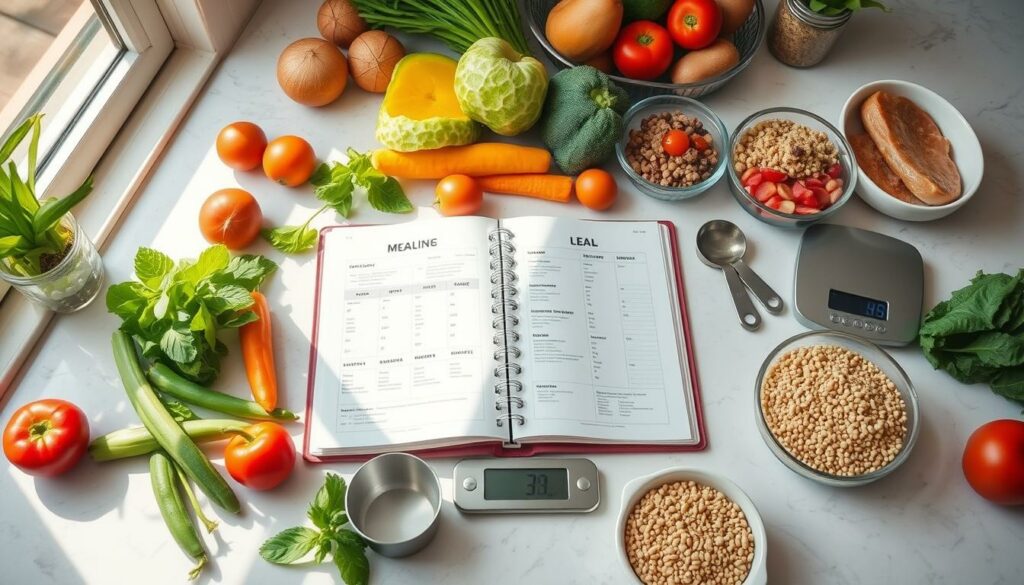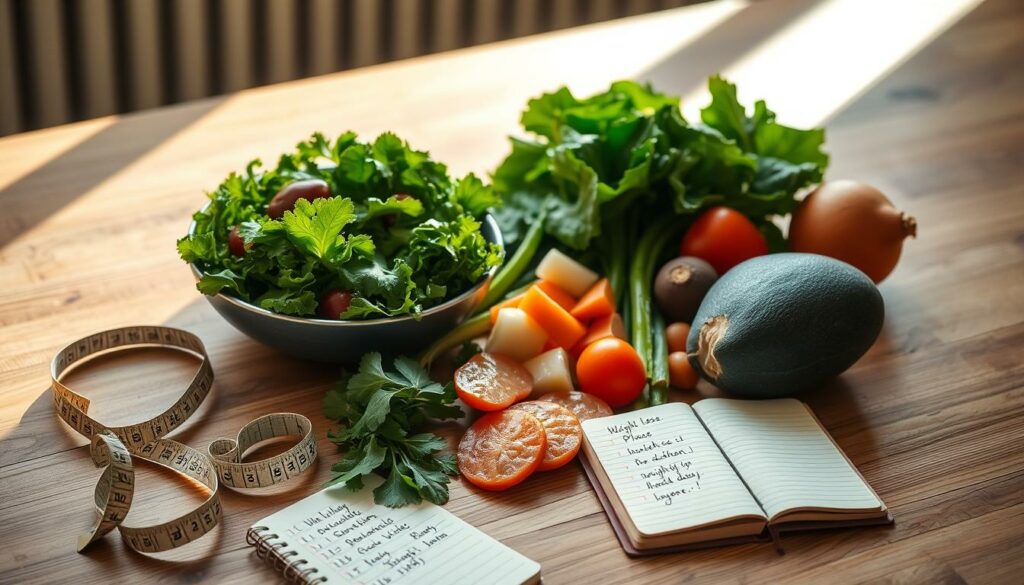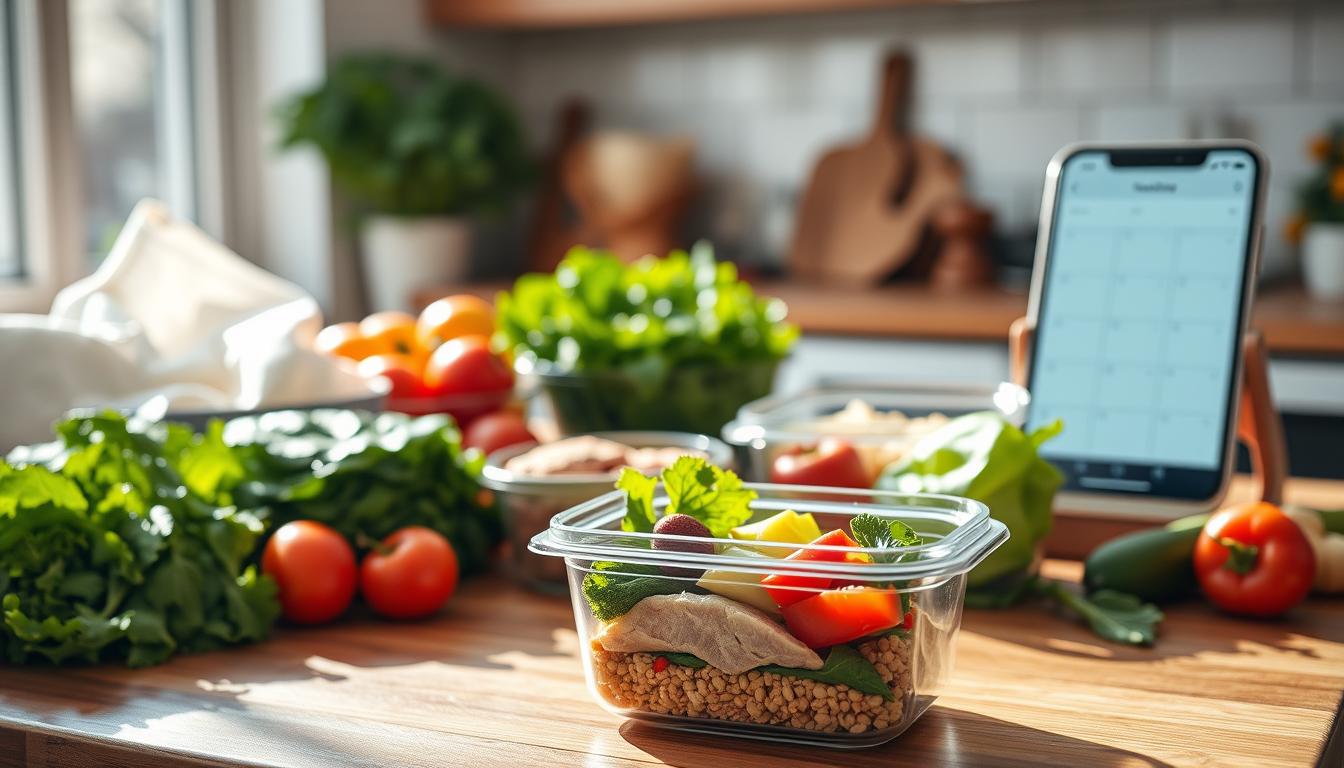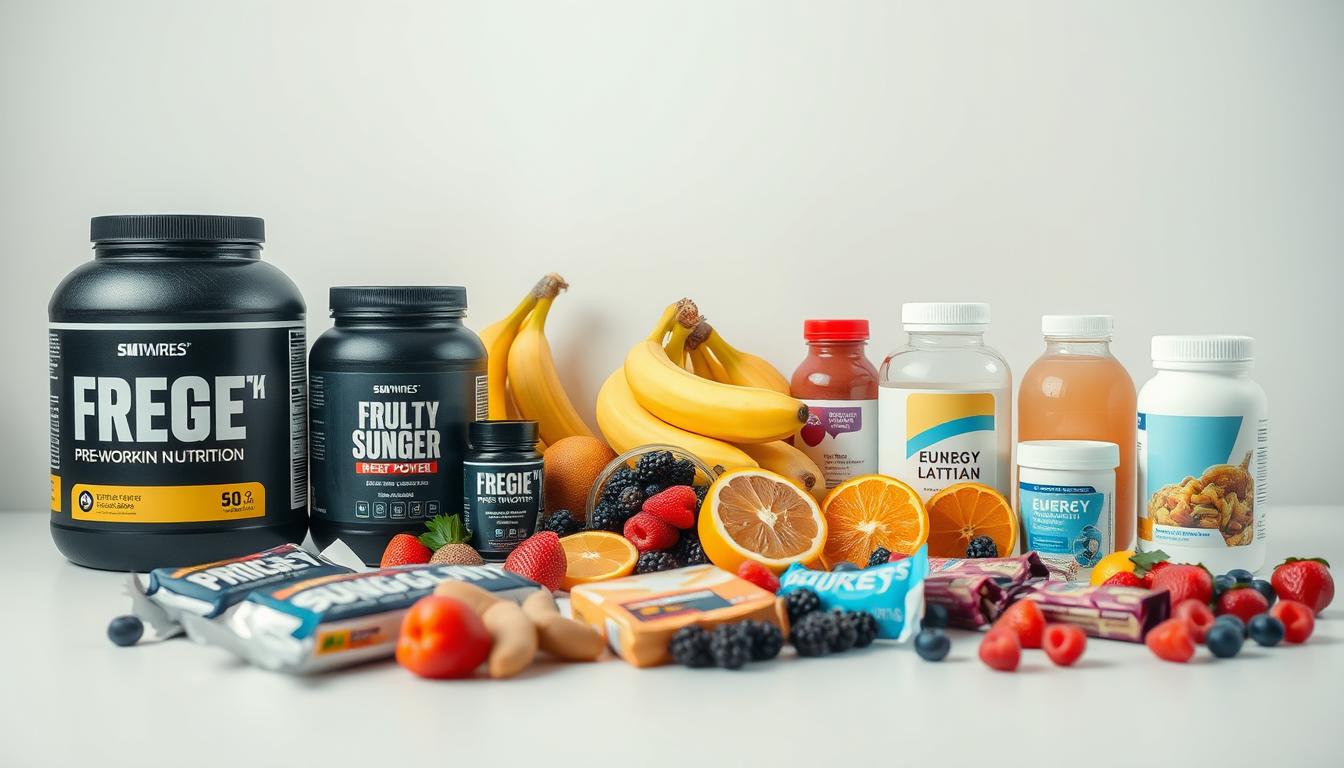Starting a weight loss journey is both thrilling and daunting.
One key to success is planning your meals. This way, you can keep track of calories and steer clear of unhealthy choices.
A good meal plan is vital for a balanced diet. It’s the first step towards a healthier life.
Key Takeaways
- Effective meal planning is crucial for weight loss.
- A balanced diet is essential for sustainable weight loss.
- Planning meals helps control calorie intake.
- Avoid last-minute, unhealthy food choices.
- Start planning your meals for a healthier lifestyle.
Understanding the Basics of Healthy Meal Planning
To reach your weight loss goals, knowing the basics of healthy meal planning is key. It’s not just about cutting calories. It’s about making a balanced diet that feeds your body and helps you lose weight.
What is Meal Planning?
Meal planning means planning and organizing your meals ahead of time. It saves time, cuts down on food waste, and ensures you eat healthy, nutritious meals. By planning, you avoid unhealthy choices and stay on diet track.
Key aspects of meal planning include:
- Deciding on your dietary goals and preferences
- Creating a shopping list based on your meal plan
- Preparing meals in advance to save time
- Storing meals properly to maintain freshness
Benefits of Meal Planning for Weight Loss
Meal planning has many benefits for losing weight, including:
- Reduced temptation: Having healthy meals ready helps you avoid unhealthy cravings.
- Time savings: Meal planning saves you from last-minute takeouts or dining out.
- Cost-effective: It reduces food waste and saves money.
- Nutritional balance: A good meal plan ensures you get all the nutrients for health.

Essential Nutritional Components
A good meal plan for weight loss needs a balance of key nutrients. These include:
- Proteins: They help repair and grow muscles. Include lean meats, fish, eggs, and plant-based options.
- Healthy Fats: They regulate hormones and are good for health. Nuts, seeds, avocados, and olive oil are great.
- Complex Carbohydrates: They give sustained energy and fiber. Choose whole grains, fruits, and vegetables.
By adding these nutrients to your meal plan, you create a balanced diet. This diet supports your weight loss goals and overall health.
Setting Realistic Weight Loss Goals
Your journey to a healthier you starts with setting realistic weight loss goals. It’s key to know what makes a goal realistic and how to plan your meals accordingly.
Determining Your Ideal Weight
To set a realistic weight loss goal, first figure out your ideal weight. Consider your height, age, activity level, and health.
Factors to Consider:
- Height and body frame
- Age and gender
- Activity level and lifestyle
- Health conditions and dietary restrictions
| Height (feet) | Age Group | Ideal Weight Range (lbs) |
|---|---|---|
| 5’2″ | 20-39 | 111-136 |
| 5’6″ | 20-39 | 129-157 |
| 5’10” | 20-39 | 146-177 |
SMART Goals for Meal Planning
After figuring out your ideal weight, set SMART goals for meal planning. This makes your goals clear and achievable.
For example: Instead of saying “I want to lose weight,” aim for “I will lose 10 pounds in 3 months with a balanced meal plan and regular exercise.”
Creating SMART Goals:
- Specific: Clearly define your goal, like losing a certain amount of weight.
- Measurable: Make your goal quantifiable so you can track your progress.
- Achievable: Make sure your goal fits your lifestyle and health.
- Relevant: Align your goal with your health aspirations.
- Time-bound: Set a specific time frame to achieve your goal.

Setting realistic weight loss goals and planning your meals can keep you motivated. Adding weight loss meal ideas to your plan makes it more enjoyable and sustainable.
Creating a Balanced Meal Plan
Making a balanced meal plan is key to losing weight. It ensures you get the nutrients you need while keeping calories low.
To make a balanced meal plan, you need to know about nutrition basics. This includes macronutrients and how much to eat. Knowing this helps you choose the right foods.
Macronutrients Explained
Macronutrients give you energy and help your body grow. They are proteins, carbohydrates, and fats.
- Proteins help build and fix tissues like muscles and bones.
- Carbohydrates give you energy. They are simple (sugars) and complex (starches and fibers).
- Fats are important for brain function and hormone production. They are divided into saturated and unsaturated fats.
Knowing how each macronutrient works helps you make a diet that supports weight loss. For instance, eating more proteins and healthy fats can keep you full and prevent overeating.
Planning Your Plate: Portion Control
Controlling your portions is vital for a good meal plan. It helps you eat the right amount of calories and nutrients without eating too much.
To control your portions, try these tips:
- Use a food scale or measuring cups to measure your food.
- Read food labels to understand serving sizes.
- Eat slowly and stop when you feel satisfied, not stuffed.
Sample Balanced Meal Ideas
Here are some balanced meals for a low-calorie diet:
- Grilled chicken breast with quinoa and steamed vegetables.
- Salmon with brown rice and a side salad dressed with olive oil and vinegar.
- Lentil soup with whole-grain bread and a mixed greens salad.
These meals are tasty and full of nutrients. They are great for losing weight. Eating a variety of foods in your meal plan helps you stay on track and reach your weight loss goals.
Preparing Your Kitchen for Success
Getting your kitchen ready is key to a smooth diet meal planning journey. With the right tools and ingredients, meal prep becomes easy. This helps you stick to your weight loss plan.
Essential Tools for Meal Prep
The right tools make meal prep better. You’ll need sharp knives, cutting boards, a slow cooker, and measuring cups. Quality tools make prep work efficient and safe.
A sharp knife speeds up chopping veggies and lowers accident risk. A slow cooker is great for meals that cook all day, ready for dinner.
Stocking a Healthy Pantry
A good pantry is essential for diet meal planning. It keeps you ready to make healthy meals anytime. Stock whole grains, canned beans, spices, and healthy oils.
Bonnie Taub-Dix, RDN, CDN said, “A well-stocked pantry is key to healthy eating.” This shows how important the right ingredients are for healthy meals.
The Importance of Meal Prep Containers
Meal prep containers are vital for portion control and organization. They help you portion meals correctly, making healthy eating easy on the go.
A study found that meal prep containers reduce food waste and save time. They’re a must for serious diet meal planning.
By focusing on these areas, you can make your kitchen ready for success. This makes diet meal planning more efficient and fun.
Choosing the Right Foods for Weight Loss
Choosing the right foods is key to losing weight. The quality of your diet greatly affects your weight loss journey. It’s all about the nutrients you get from what you eat.
Nutrient-Dense Foods to Include
Adding nutrient-dense foods to your diet is crucial. These foods are packed with vitamins, minerals, and good stuff while being low in calories. Some examples are:
- Leafy greens like spinach and kale
- Lean proteins such as chicken, fish, and tofu
- Whole grains like quinoa, brown rice, and whole wheat
- Fruits and vegetables, which are rich in fiber and antioxidants
Foods to Avoid While Meal Planning
Knowing which foods to avoid is just as important. Some foods can slow down your weight loss. Try to limit or avoid these:
- Processed foods high in unhealthy fats and sodium
- Foods high in added sugars, such as sugary drinks and desserts
- Refined carbohydrates, like white bread and pasta
Here’s a table to help you see the difference between healthy and unhealthy foods:
| Food Category | Healthy Choices | Unhealthy Choices |
|---|---|---|
| Grains | Whole wheat, quinoa | White bread, sugary cereals |
| Proteins | Lean chicken, fish, tofu | Processed meats, high-fat red meat |
| Vegetables | Leafy greens, broccoli, bell peppers | Fried vegetables, vegetable oils |
By choosing nutrient-dense foods and avoiding bad ones, you can make a weight loss meal planner that works well and lasts.
Designing a Weekly Meal Schedule
To reach your weight loss goals, creating a weekly meal plan is key. A good meal plan keeps you consistent and avoids unhealthy choices. It’s all about planning ahead.
Tips for Planning Your Week
Think about your schedule, what you like to eat, and what’s available when planning your week. Identify busy days and plan easy meals for them. Choose your favorite healthy meals and mix them up to keep things interesting.
Plan meals around what’s in season and on sale. This saves money and ensures you eat fresh, nutritious foods. It’s a great way to support your healthy eating plan for weight loss.
Balancing Meals and Snacks
It’s important to balance your meals and snacks for the right nutrients all day. Aim for three main meals and one or two snacks, based on your activity and hunger. Make sure your meals have proteins, healthy fats, and complex carbs.
For snacks, pick foods like fruits, nuts, and carrot sticks with hummus. Stay away from sugary and unhealthy fats. This balance helps in your weight loss and overall health.
Flexible Meal Strategies
Flexibility is crucial in meal planning. Life can surprise you, and a strict plan can be stressful. Have a backup plan, like healthy, ready-to-eat meals, for unexpected moments.
Regularly check and tweak your meal plan as needed. You might need to adjust portion sizes, swap meals, or change when you eat. This keeps your plan working for you, even as your needs change.
Incorporating Variety in Your Meal Plan
Variety makes life exciting, and this is true for meal planning too. A diverse meal plan makes losing weight fun and keeps you on track.
Having different meals keeps your diet fresh and ensures you get all nutrients. This is key for staying healthy and avoiding nutrient gaps from eating the same foods all the time.
The Importance of Variety
It’s vital to include many foods in your meal plan. Different foods offer different nutrients, so a varied diet is essential. This helps your body get everything it needs.
- Reduces the risk of nutrient deficiencies
- Keeps your diet interesting and prevents boredom
- Allows you to enjoy different cuisines and cooking methods
Also, a varied diet helps you develop lasting healthy eating habits. Trying new cuisines and recipes can lead to discovering healthy dishes you love.
Creative Cooking Methods
Trying new cooking methods can make meals more exciting. Techniques like grilling, roasting, and stir-frying enhance flavors and textures.
Here are some creative cooking methods to try:
- Grilling: Adds a smoky flavor and nice char to vegetables and lean proteins.
- Roasting: Enhances the natural sweetness of vegetables and can be used for a variety of proteins.
- Stir-frying: Quick and versatile, allowing you to combine a variety of vegetables and proteins in one dish.
Adapting Recipes for Meal Plans
Adapting recipes means changing ingredients and sizes to fit your diet. This way, you can enjoy your favorite dishes while losing weight.
To adapt a recipe, follow these steps:
- Choose recipes that can be easily scaled up or down.
- Substitute ingredients with healthier alternatives when possible.
- Adjust portion sizes based on your individual calorie needs.
By adding variety to your meal plan and getting creative, healthy eating for weight loss can be both fun and sustainable.
Staying on Track with Your Plan
Staying on track with your meal plan takes commitment and the right strategies. It also means making ongoing adjustments. As you start your weight loss journey, knowing how to keep going is key.
Monitoring Your Progress
Tracking your progress is crucial. It helps you see what works and what doesn’t in your meal plan. Use a food diary or a mobile app to log your meals and track your weight loss.
Tips to Stay Motivated
Staying motivated is essential for your meal plan’s success. Celebrate small victories to keep you going. Also, joining a community or support group focused on clean eating for weight loss can offer the support and accountability you need.
- Set realistic goals and celebrate when you achieve them.
- Find a meal planning community for support.
- Reward yourself with non-food related treats.
Making Adjustments as Needed
Flexibility is important in meal planning. As you progress, you might find some weight loss meal ideas work better than others. Be ready to adjust your meal plan as needed to keep moving forward.
Regularly reviewing and adjusting your meal plan is vital. This might mean changing portion sizes, trying new recipes, or adjusting your macronutrient balance. It helps you stay on track towards your weight loss goals.
Addressing Common Challenges in Meal Planning
When you try to stick to a meal plan, you might hit some bumps. It’s not just about picking healthy foods. It’s also about dealing with real-life issues that can stop you from reaching your goals.
Overcoming Time Constraints
One big challenge is finding time to plan and cook meals. To beat this, try meal prepping in advance. Spend a few hours on the weekend cooking for the week. This saves time and keeps you on track with healthy meals.
Also, keep your meals simple. You don’t need fancy, long meals. Simple, low calorie meal plans work well and are quicker to make.
Managing Cravings and Emotional Eating
Cravings and emotional eating can block your meal planning success. To fight cravings, find healthier swaps for your favorite snacks. For example, choose Greek yogurt with fruit instead of ice cream.
Dealing with emotional eating is tougher. It’s about using food to cope with stress or other feelings. Try mindful eating. This means listening to your hunger, eating slowly, and enjoying your food.
Solutions for Dining Out
Eating out can be hard when you’re on a meal plan. But, with some planning, you can make smart choices. Look for places that offer healthy recipes for weight loss. Choose dishes that are grilled, baked, or steamed, not fried.
It’s also key to watch your portion sizes. Restaurants often give big portions. Think about sharing a meal or taking leftovers home.
The Role of Support Systems in Meal Planning
Having a support system can really help with diet meal planning. A good weight loss meal planner is key to reaching your goals.
Talking to your loved ones can give you the push you need. Share your weight loss goals with family and friends. This way, they can support you and keep you on track.
Building a Support Network
Joining online communities about diet meal planning can be very helpful. You’ll find recipes, tips, and motivation. It’s a great way to connect with others who face similar challenges.
Seeking Professional Guidance
If making a meal plan is tough, get help from a registered dietitian or nutritionist. They can give you advice that fits your needs. This can help you overcome obstacles and reach your weight loss goals.
Using these support systems can help you stick to your meal plan. This way, you can successfully lose weight.


